Schotia brachypetala
| Botanical Name | Schotia brachypetala |
|||||||||||
| Family | Caesalpinioideae - The cassia and musasa subfamily of Fabaceae. |
|||||||||||
| Pronunciation | SHOT-ee-uh brak-ee-PET-al-uh |
|||||||||||
| Common Name(s) |
English: Weeping boer-bean
Afrikaans: Huilboerboon
IsiXhosa: umgxama; umaphipha; Ishimnumyane
IsiZulu: Ihluze; Umgxamu; Uvovo
Sesotho sa Leboa: Molope
Setswana: Molope; Nwavilombe
Tshivenda: Mulibi; Mununzwa; Mununzwu
|
|||||||||||
| Plant Group |
|
|||||||||||
| Plant Size |
|
|||||||||||
| Position |
|
|||||||||||
| General Information |
|
|||||||||||
| Specific Information | Schotia brachypetala is a handsome medium sized tree with a low branching habit and an attractive, wide spreading rounded crown. It is a decorative garden tree with an exceptional flower display. The waxy, crimson flowers and copious nectar attract a wide variety of birds and insects to the garden. After flowering large seed pods develop which burst open when ripe and attract parrots and brown headed loeries (tauraco) that come to eat the seeds. The seeds are large, light brown and have a distinctive yellow aril attached to them. I have found that the seeds of the schotia species in the Eastern Cape are invariably heavily parasitised. The tree is evergreen in warmer regions but deciduous in frosty areas. The common name of 'Weeping boer-bean' is derived from the abundant nectar produced by the flowers. Do not plant over paved areas, car parks or close to permanent structures due to the dripping nectar in spring. Young trees need to be protected from frost. Growth is quite slow, especially when young, but growth rate increases as tree gets older. |
|||||||||||
| Ad Break | ||||||||||||
| Flowers | ||||||||||||
| Description | dense heads of short petaled flowers dripping with nectar |
|||||||||||
| Season |
|
|||||||||||
| Colour |
|
|||||||||||
| Growth Rate |
|
|||||||||||
| Plant Uses |
|
|||||||||||
| Distribution and Habitat | from Umtata in the Eastern Cape, through KwaZulu-Natal, Swaziland, Mpumalanga, Northern Province, Mozambique and Zimbabwe, in warm dry habitats, frequently on the banks of streams and rivers in bushveld, woodland and scrub forest |
|||||||||||
| Planting Suggestions | For best results, plant in a sunny position and water generously in summer. Once well established the tree is water wise but better results will be had if the summer watering is continued. Planted in heavy soils, growth will be slower and the tree will be smaller. Keep young trees watered at regular intervals and protected from frost until established. The old method of digging a deep hole and filling it with soil and compost has resulted in many trees failing to thrive, dying, rotting at the base or worse still, falling over in later years due to poor root development. Refer to the following sites for the best method of planting trees: International Society of Arboriculture: New Tree Planting Tree People: Plant the right way For those of you who have a clay problem try: |
|||||||||||
| Medicinal Uses | Liquid from the boiled bark are used to treat heartburn and hangovers. Mixtures of the bark and root are used to purify the blood, to treat nervous heart conditions and diarrhoea, and to strengthen the body. The roasted seeds are edible, low in fat and protein but high in carbohydrates. They were widely used as a valuable food source and as a coffee substitute by the early settlers. The bark produces a red-brown or red coloured dye. |
|||||||||||
| Ad Break | ||||||||||||



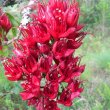
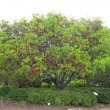
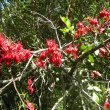
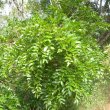
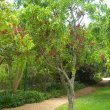


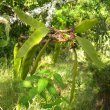
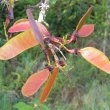
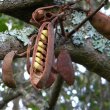
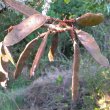


Comments
No flowers
Hello there, I planted a 2.0 metre plant that was about 40mm at the base two years ago. This tree is planted in sandy soil and on the west coast (Langebaan) of South Africa. we get winter rain and we never get frost. The tree is now about 3.0 meters high and is very skinny if you understand what I mean, we also have a lot of wind but the tree is fairly well protected so it does get wind from the west and north. No flowers as yet and I would like your input please. Is this normal and if so, at what time should we expect to see some flowers?
Many Thanks
ERrol
Schotia brachypetala - flowering
Hi Errol
It sound as if your tree is still a bit young to start flowering. I have a young tree of about 6 years old and it has not yet produced flowers, despite the fact that it is in a sheltered position surrounded by other trees and shrubs, cutting down the wind to a minimum. My main concern is that the tree comes from a sub-tropical habitat with high humidity, often near rivers and invariably in a bushy environment. It grows best in Natal and Mpumalanga where summer rainfall is high, with a resting period during winter when no rain falls. As I am positioned south of this area, my trees flower only after summers with higher rainfall than normal - about every three to four years. Being so far from its preferred habitat, your tree may not flourish and it is possible that flowering will be delayed or suppressed altogether. All I can suggest is that you water it very well throughout the summer months and make sure it is well composted and mulched during this time. I'd also be tempted to remove the mulch during the wet winter period to keep it as dry as possible during its dormant season.
Non flowering Schotia Brachypetala
Thank you for your advice. Some suppliers should be retired as they should not be able to sell plants and trees that will not do what the seller says it will do. " Fast growing large tree with large bunches or red flowers"
Many Thanks
Errol
Planting 'indigenous'
I quite agree. Many nurseries around here are now adapting their stock to plants that grow within the region in which the nursery is situated but 'new' ideas sometimes take a while to be accepted. 'Indigenous' does not automatically mean that all South African plants can be used in any area of the country. I find it incongruous that a sub-tropical, summer rainfall area plant should even be offered for sale in a winter rainfall area!
Regards
Lorraine
Um-er Perhaps I was a bit hasty!
Hi Errol
I am busy updating my notes for this plant as well as the photos. I came across a couple of photos that I took at the Kirstenbosh Botanical gardens last year - they had slipped my mind completely. The gardens are quite well-sheltered but perhaps you need not despair. The plants at the gardens are very well fertilised with organic mulch and clearly receive their water needs. I have added them to the pictures above. Reportedly the trees grow rather slowly at first but faster as they mature. Keep caring for your tree and I am sure you will be rewarded in time.
watering new tree "Weeping boer-bean"
Could you kindly specify how often a newly planted weeping boer-bean should be watered. Is it a bucket full once a day, once every 3rd day or once a week. That is in the Eastern Cape region.
Watering a newly planted tree
Hi Sheila
To be frank, none of the above! Frequent, small quantities of water will result in shallow roots and this is something you most definitely don't want. The roots must be encouraged to seek water deep in the ground where they will anchor the tree firmly, search for nutrients, and, in the event of our frequent droughts, will be able to seek water far below the surface. My suggestion is that you water only once a week but use at least five buckets of water, allowing each bucketful to sink down before adding the next. As the tree grows, you will have to increase the number of buckets.
Better still, if you have a hose, let the water just dribble out for a couple of hours. I put the end of the hose in a tin can (baked bean type) so that the water flow does not make a deep hole in the ground.
A thick layer of mulch around the tree to the drip area will help keep the soil moist and cool, while it feeds it with nutrients and encourages bacterial growth. Just make sure that the mulch is kept away from the area immediately around the trunk.
One last thing. Water your tree even if you have had rain, unless the rain has been particularly good - 20 or 30 mm. Light rain will not go deep enough to feed the roots.
Kind regards
Lorraine
Watering Weeping boer-bean
Hi Lorraine
Thank you so much for your very useful reply. We look forward to this beautiful tree growing and hopefully flowering before three to six years.
Hi Sheila
With good care I am sure you will have gratifying results. I love this tree. In full flower it is alive with birds and bees, especially sunbirds. Don't despair if it doesn't take off immediately. These trees grow slowly for the first two or three years before they really take off.
"Weeping Boer-bean"
thank you Lorraine. Will do and keep you posted.
boerboon
Hi, I'm in Bloem and would love to plant one of these, my concerns are how badly will the frost effect the tree and I have quite shallow soil, dolerite bolders. I have managed to dig to about 1.6 m deep, do you think it would do well?
Weeping boerboon in Bloemfontein
Hi Blake
As lovely as this tree is, I have some reservations about it adapting to the climate experienced in Bloem. This species originates from environments with a relatively high air humidity, where it grows along the edges of forests and along streams. It can tolerate light frosts from time to time but will be unlikely survive frequent or heavy frost conditions. If it were to survive, it most certainly will not thrive. The climatic conditions in the Free State will negatively affect growth and it may not flower at all.
Sorry I can't be more positive. If you decide to take the chance anyway, make sure that you protect the tree in winter with some sort of covering (sacking, shade cloth) for the first three or four years.
Kind regards
Lorraine
Weeping Boer-Bean Roots
Good day,
I have a fairly small garden and would like to plant a tree that will not lift my paving i.e. not too invasive roots. It will be a few metres away from the nearest wall and paving. I think (and I would appreciate some confirmation) that the Acacias mostly have quite invasive roots. The boer bean looks more suitable. Also do you think it will be OK in Johannesburg? Many thanks!
Suitability of Schotia brachypetala for Johannesburg
Hi Louis
The Weeping Boer Bean may be an option but I must draw your attention to the following:
Frost resistance: This tree comes from a sub-tropical region and is only half-hardy to frost. This means it will need to be covered during winter for the first two or three years and will suffer from some frost damage during the winters thereafter. It will be seriously damaged if frost is heavy and a black frost will in all likelihood kill it. The icy winter winds of Johannesburg will also be detrimental.
Although it is away from the paving, the nectar dripping from the flowers will preclude the use of, for example, garden furniture beneath it during flowering time; however this may not be problematic because the cold weather will certainly reduce or even prevent the tree from flowering.
With reference to Acacias, some do in fact have an extensive sub-surface root system along with the tap root. Over time these roots thicken and can become a problem with paving and garden walls.
Random Harvest, an indigenous nursery near Randburg, has developed a list of almost 50 smaller trees with non-invasive root systems for planting near pools and which are adapted to conditions in Gauteng. This list is also useful for trees for smaller gardens. Should you decide against planting the Boer-bean, you may find an alternative in the list. Go to:
http://www.randomharvestnursery.co.za/RandomHarvestNews/IndigenousGarden...
I hope this is useful in making your final decision - one has to be so careful with one's choice when there is only space for one or two trees in a garden.
Kind regards
Lorraine
Hi Lorraine,
Hi Lorraine,
Thank you so much for this very very useful feedback - it is much appreciated!
Kind regards
Louis
Thank you
Hi Louis
Happy to help. I hope you find the right tree for you and your garden.
Kind regards
Lorraine
Replanting a boerboon
We live in JHB and have a Boerboon tree which is about 1.5m tall and has base stem of about 150mm which we would like to move.Could you please give me some advise on how to replant this tree in a new location as i would hate to kill it but we need the space.
Replanting a boerboon
Hi Anthony
This doesn't seem to be too much of a problem as the tree is still quite small. The following two articles will give you good information on how to go about this process. You shouldn't have a major problem and with care the transplant has every chance of being successful.
http://www.ehow.com/how_12225730_uproot-tree-killing.html
http://www.ehow.com/how_7378232_uproot-trees-transplanting.html
Tree planting methods have changed from the old method of a huge deep hole filled with rich soil and nutrients. I was sceptical of the 'new' method at first but have had much better results since I have utilised it. The following article is very used in explaining how to re-plant the tree:
http://www.treepeople.org/plant-right-way
All the best with this - post some photos of the process!
Kind regards
Lorraine
Flowering age of weeping boer bean
I live at winston park in kwa-zulu natal. I planted a tree of about 20 cm in height about 6 years ago. It is now about five metres high. When can I expect it to start flowering ?
Age at flowering
Hi Tienie
My sincere apologies for not having replied to your query.
Unfortunately I am unable to answer your question. This is a question I am asked over and over again about all sorts of trees but there is almost no data available on this. Members of the pea-flower family usually flower quite young, but the Coral trees (also pea-flower family) don't flower until they are ten years old.
I do hope your tree flowers soon.
Kind regards
Lorraine
Weeping Boer Bean
Hi - we live in Kyalami in Gauteng and planted a Weeping Boer Bean tree last year. It produced new leaves and flowered late last winter. It has not grown this year and we've had no flowers. There is grass growing right up to the stem of the tree. Could this cause the problem. Otherwise we are really not sure what to do.
Schotia brachypetala in Gauteng
Hi Rod
Firstly, my apologies for the tardy reply.
I doubt that the grass has anything to do with the tree not flowering.
This species originates from sub-tropical areas (See 'Distribution and Habitat' above) with a relatively high air humidity and warm winter temperatures. Frost is rare but it can tolerate light frosts from time to time with some die back. The tree will not thrive in cold winter weather conditions. Frequent or heavy frost and icy wind conditions will ultimately kill it.
The climatic conditions in your area will negatively affect growth and flowering of your tree. The reason for its initial growth and flowering is probably due to having been in a protected nursery environment.
Unless you are able to provide protection in the form of heavy shade netting or other covering during winter for the first three years, you may find that the tree will remain small and possibly not flower at all.
Kind regards
Lorraine
Discuss this plant
Share knowledge, ask a question or give an experience.